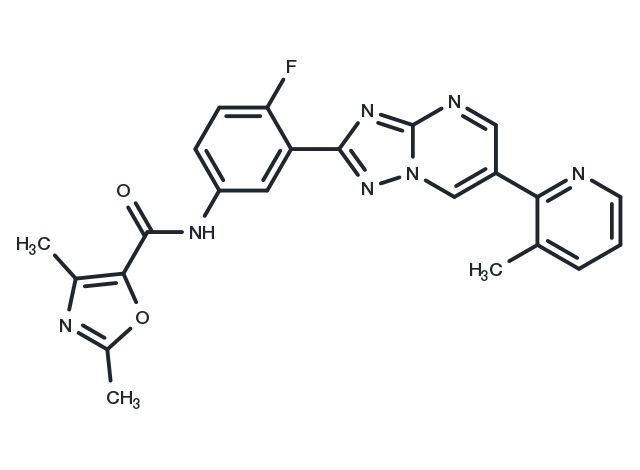Powder: -20°C for 3 years | In solvent: -80°C for 1 year


LXE408 is an orally active, kinetoplastid-selective proteasome inhibitor, exhibiting non-competitive inhibitory effects. It demonstrates an IC50 of 0.04 μM for L. donovani proteasome and an EC50 of 0.04 μM for L. donovani. Moreover, LXE408 shows limited ability to traverse the blood-brain barrier. Hence, LXE408 holds promise for advancing research in the field of visceral leishmaniasis (VL).

| Description | LXE408 is an orally active, kinetoplastid-selective proteasome inhibitor, exhibiting non-competitive inhibitory effects. It demonstrates an IC50 of 0.04 μM for L. donovani proteasome and an EC50 of 0.04 μM for L. donovani. Moreover, LXE408 shows limited ability to traverse the blood-brain barrier. Hence, LXE408 holds promise for advancing research in the field of visceral leishmaniasis (VL). |
| In vitro | LXE408 (compound 1) forms a ternary complex by occupying the pocket within the proteasome. It exhibits no hERG channel inhibition (IC 50 >30 μM) as determined by a manual patch clamp assay and displays a minimal ability to cross the blood-brain barrier (brain/plasma AUC ratio=0.03 in mice)[1]. |
| In vivo | LXE408, administered orally at doses ranging from 0.3 to 10 mg/kg twice daily for eight days, significantly decreases liver parasite burden in a dose-dependent manner in mice. In BALB/c mice infected with L. major, treatments with LXE408 at 1, 3, 10, and 20 mg/kg orally, twice daily for 10 days, effectively heal skin lesions at the tail base. Pharmacokinetic analysis reveals that LXE408 has a half-life (T 1/2) of 3.3 hours at 5 mg/kg intravenously (IV) and 20 mg/kg orally in mice, and 3.8 hours at 3 mg/kg IV and 10 mg/kg orally in male Sprague-Dawley rats, with a clearance (CL) rate of 2.1 mL/min/kg and a steady-state volume of distribution (V ss) of 0.53 L/kg. In male beagle dogs and cynomolgus monkeys, the T 1/2 at 0.3 mg/kg IV and 1.0 mg/kg orally, and 0.3 mg/kg IV and 10 mg/kg orally, are 3.8 and 9.7 hours, respectively. In female BALB/c mice infected with L. donovani, oral administration of LXE408 at 0.3, 1, 3, and 10 mg/kg twice daily for eight days achieves a reduction in liver parasite burden of up to 95% and >99.84% at doses of 1 mg/kg and 10 mg/kg, respectively. A separate pharmacokinetic study in Balb/C mice shows that 5 mg/kg IV and 20 mg/kg orally results in a T 1/2 of 3.3 hours, a CL of 2.3 mL/min/kg, and a V ss of 0.63 L/kg, indicating its potent antiparasitic effects and significant pharmacokinetic properties across different animal models and dosing regimens. |
| Synonyms | LXE408 |
| Molecular Weight | 443.442 |
| Formula | C23H18FN7O2 |
| CAS No. | 1799330-15-6 |
Powder: -20°C for 3 years | In solvent: -80°C for 1 year
You can also refer to dose conversion for different animals. More
bottom
Please see Inhibitor Handling Instructions for more frequently ask questions. Topics include: how to prepare stock solutions, how to store products, and cautions on cell-based assays & animal experiments, etc.
LXE408 1799330-15-6 LXE-408 LXE 408 inhibitor inhibit
